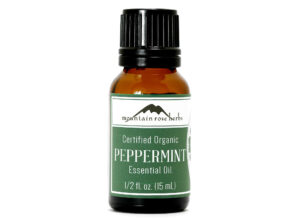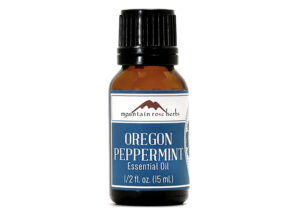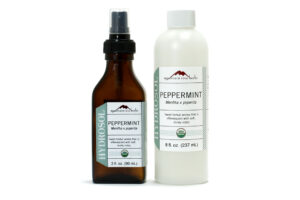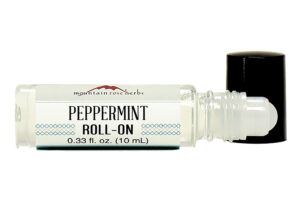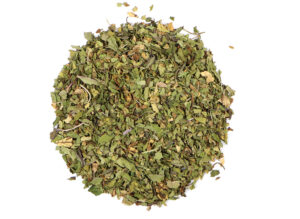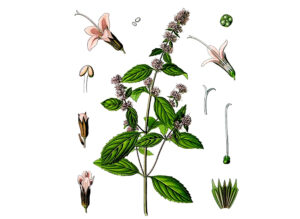Peppermint Essential Oil
Peppermint essential oil, which is made from the peppermint plant, Mentha piperita, has a long history of medicinal use for a wide range of maladies from mild stomach upset to muscle pain and even as a treatment for bacterial and viral infections. With its long history of use, peppermint oil continues to be beneficial for many common illnesses and a few surprising purposes as well.
Medicinal Uses for Peppermint Oil Extract
While modern medicine offers many outstanding treatments for a wide range of maladies, it’s difficult to overlook centuries of wisdom that goes along with using peppermint oil to treat these same conditions – not to mention a wide range of clinical studies to support these ages old claims (some dating back to Ancient Egypt, Rome, and Greece). These are a few examples of the reported benefits of peppermint oil extract.
Irritable Bowel Syndrome – One study, reported on in the Journal of Clinical Gastroenterology, determined that peppermint oil is “significantly superior to placebo” medication for the treatment of IBS symptoms in the short term. A separate study, published in Cochrane Database Systematic Reviews determined that peppermint essential oil (along with peppermint leaf) works effectively as an antispasmodic for treatment of IBS. Peppermint is also helpful in relieving bloating, flatulence, and indigestion, according to the University of Maryland Medical Center.
Colon Exams – Peppermint oil capsules have been prescribed orally to patients prior to a colonoscopy to reduce colon spasms, reduce pain, and reduce the time for the procedure. Peppermint oil in a barium enema is thought to relax the colon.
Muscle Pain – When it comes to muscle aches and pains, peppermint essential oil is widely known to cause relief when applied topically. That is why it’s used so often in massage oils and topical ointments for sports pain.
Oral Health – Another area where peppermint essential oil is believed to be effective is in the area of oral health. It is widely used in mouthwash and toothpaste not only for its breath freshening capabilities, but also for its healing impact on overall oral health. According to WebMD, peppermint essential oil is widely used to treat toothaches, inflammation of the mouth (and throat), bacterial infections, viral infections, and nerve pain.
Nausea Treatment – The National Cancer Institute also suggests the use of peppermint essential oil and aromatherapy as a potential treatment for post-operative nausea. It goes on to recommend the use of peppermint oil in combination with eucalyptus oil for headaches associated with cancer and cancer treatments.
The University of Maryland Medical Center sites many more uses for peppermint. It is used to treat a number of other ailments, including menstrual cramps, anxiety, headaches, skin irritations, and depression because of its number and calming effect. Some chest congestion rubs that treat the common cold have it as one of the ingredients. Because it can kill certain types of viruses, fungus, and bacteria in test tubes, it is suggested that it may have antiviral, antifungal, and antibacterial properties.
Other Peppermint Essential Oil Uses
Aside from the medicinal benefits of peppermint oil extract, there are plenty of other ways peppermint essential oil is used every day, including the following uses and more.
Study Aid: A study published in the International Journal of Neuroscience determined that peppermint essential oil aroma increases alertness and enhances memory making it an excellent choice for study nights. So much so that the power of peppermint was put to the test when a principal of Silver Spring middle school ordered 3,600 peppermint candies for the school’s 800 students in order to boost their scores on statewide tests.
Home Fragrance: Many home fragrance products include peppermint oil or peppermint extract. It provides a fresh, clean smell many people find appealing.
Mouse Repellent: Place several drops on cotton balls and place the balls at strategic locations around your home. It smells great and mice hate the scent.
As you can see there are many potential benefits for using peppermint essential oils to treat various conditions, to help your home smell clean and fresh, to help you feel better when feeling nauseous, and even improve your mood and memory. With so many potential benefits it’s a good plan to consider looking for new ways to bring the powerfully healing fragrance of peppermint essential oil into your home.
Buy Organic Peppermint Essential Oil
Organic peppermint oil is steam distilled from the aerial portions of Mentha piperita. This top note has a minty, hot, and herbaceous scent that is popular in soaps, room sprays, and cleaning recipes. Mild climate stress in the growing conditions of the plant increases the oil content and sesquiterpene levels in the oil. Peppermint essential oil blends well with grapefruit, marjoram, pine, eucalyptus, or rosemary.
Blends Well With
Basil, benzoin, black pepper, cypress, eucalyptus, geranium, grapefruit, juniper, lavender, lemon, marjoram, niaouli, pine, rosemary, and tea tree
Packaging
1/2 oz. and 1 oz. essential oils are packaged in amber glass bottles with drop reducers for easy application. Larger sizes are packaged in amber screw cap bottles and do not come with reducers or droppers.
Precautions
This oil is potentially choleretic, neurotoxic, and can irritate mucous membranes. Never use essential oils undiluted, in eyes or mucus membranes. Do not take internally unless working with a qualified and expert practitioner. Keep away from children.
Before using topically, perform a small patch test on your inner forearm or back by applying a small quantity of diluted essential oil and apply a bandage. Wash the area if you experience any irritation. If no irritation occurs after 48 hours it is safe to use on your skin.
Buy Organic Peppermint Essential Oil, Oregon
Our Oregon peppermint essential oil is steam distilled from the aerial portions of Mentha piperita. This fresh and invigorating oil is grown in Oregon in the fertile Willamette Valley. This peppermint oil offers exhilarating and uplifting notes that can be used in a wide variety of aromatherapeutic and body care recipes from soaps, body butters, perfumes, massage oils, and in the diffuser.
Peppermint oil has many similar qualities to spearmint; however, spearmint is typically softer and sweeter. The aroma can also vary depending on the region where it is grown. Mint plants are voracious growers and can be found all over the world as they can tolerate a wide range of growing conditions. Peppermint is thought to be a natural hybrid of water mint (Mentha aquatica) and spearmint (Mentha spicata).
Aroma
Softly sweet and minty with a refreshing, green aroma. It becomes warmer with more pungent herbaceous notes in the dry down.
Constituents
This oil contains menthol, menthone, and 1,8-cineole. Menthol is also found in cornmint essential oil. And menthone can be found in cornmint, pennyroyal, and sometimes geranium oils. Eucalyptus, sage, Spanish marjoram, and myrtle are also known for their 1,8-cineole content giving them similar uses as peppermint if you prefer an oil with less menthol.
Blending and Uses
This oil is cooling on the skin and invigorating for the senses. Add Oregon peppermint to massage oils with helichrysum, marjoram, and rosemary for occasional overexerted muscles from hiking, gardening or other strenuous activities.
Combine with cypress, sandalwood or clary sage in your diffuser for a calming and emotionally soothing atmosphere. For good study time blends use with ginger, black pepper, and orange to support focus and energy. These blends are also useful for personal aromatherapy pens or perfume oils.
Peppermint is immensely popular in body care recipes for chest rubs, soaps, deodorants, and even added to shampoo or conditioner for a fresh and invigorating experience. Add to refreshing body or room sprays as a single aroma or blend with lemon, spearmint, or tangerine. These same blends are great for DIY cleaning formulations around the home.
Packaging
1/2 oz., 1 oz., and 2 oz. essential oils are packaged in amber glass bottles with drop reducers for easy application. Larger sizes are packaged in amber screw cap bottles and do not come with reducers or droppers.
Safety
This oil is potentially choleretic, neurotoxic, and can irritate mucous membranes. Never use essential oils undiluted, in eyes or mucus membranes. Do not take internally unless working with a qualified healthcare practitioner. Keep away from children and pets.
Before using perform a small patch test on your inner forearm or back. Apply a small quantity of diluted essential oil and cover with a bandage. If you experience any irritation use carrier oil or cream to further dilute the essential oil, and then wash with soap and water. If no irritation occurs after 48 hours it is safe to use on your skin.
Buy Organic Peppermint Hydrosol
Organic peppermint hydrosol is best known for its use as a revitalizing and refreshing body spray, this peppermint hydrosol is well rounded and strikingly robust. It can be used liberally on the body as a general cooler or toner and is a wonderful base for DIY aroma sprays for the body and room.
Peppermint has a long and valued history in aromatherapeutic applications, with the dried leaves found inside the tombs of ancient Egypt. Peppermint is energizing, uplifting, and cooling.
Organic peppermint hydrosol can provide a wonderful refreshing sensation when used directly on the skin and may be kept in the refrigerator to amplify this effect. The light peppermint scent is fresh and is a great astringent toner or ingredient for water-based skin care formulations.
An exceptional and uplifting botanical water, organic peppermint hydrosol is much gentler than the invigorating essential oil of peppermint leaves and may be used directly on your skin. Blend with rosemary hydrosol for a mentally stimulating herbal mist, or add essential oils such as basil, juniper, or sage for a unique aroma spray. Mix in a few tablespoons of peppermint hydrosol to a relaxing foot soak at the end of your day!
Our peppermint hydrosol is created in the Pacific Northwest via water-steam distillation of fresh Mentha x piperita. Suitable for cosmetic use.
Packaging
The 3oz. size comes in an amber glass bottle with a mister top. Our 8oz., 16 oz., 64 oz., and 1 gallon bulk sizes come in plastic bottles without misters.
Buy Organic Peppermint Roll-On
Peppermint essential oil is a true classic in the world of aromatherapy. The fresh, cool aroma is stimulating for the mind and can help you stay alert. It is a popular oil to use during study or work. Peppermint oil can also help you feel a little cooler during hot weather.
This handcrafted blend is made in small batches here in our kitchen at a skin-safe 2% dilution. The convenient roll-on bottle travels easily in your bag or pocket. Organic fractionated coconut MCT oil is unscented and quickly absorbs without leaving an oily feeling, making it an excellent base.
Roll our organic peppermint blend on the back of your neck on a hot day for a pleasant cooling sensation, or on muscles after a day of rigorous activity. Use on your temples to help support a focused mind while studying, organizing, or any task that requires extra concentration. Great for any time you desire the sweet and invigorating aroma of peppermint oil.
Ingredients
Organic fractionated coconut MCT oil and organic peppermint essential oil.
Buy Organic Peppermint Leaf
Mentha x piperita is a flowering perennial that is native to Europe and has since spread worldwide. Peppermint is a natural hybrid of spearmint and water mint. It is used for its healthful properties and has many applications in food. Peppermint leaf is commonly steeped as a refreshing peppermint tea but is also popular in herbal tea blends and candies. Our peppermint leaves are organically cultivated in the United States.
Peppermint is a flowering perennial, usually growing between 12 and 35 inches in height. It is native to Europe and is actually a natural hybrid of spearmint and water mint. The herb is easy to grow in moist soil and is commonly cultivated around the world for its many applications in food and medicine.
The world’s most familiar “mint scent” is the aroma of peppermint. In Greek mythology, Menthe was turned into a peppermint plant when Proserpine, in a jealous rage, found out that Pluto was in love with her. Even earlier, Assyrians used peppermint as an offering to their fire god.
Peppermint contains an essential oil that is unique among mints for its quality and flavor. Artificial mint compounds do not effectively duplicate the aroma or medicinal properties.
Peppermint is one of the most popular herbs in teas, candies, and chewing gums. Cultivation and oil production started in the US in the 1790’s, and was a major export business by the mid 1800’s. The U.S. is still the world’s leading producer of peppermint oil, making an average of 4,117 tons annually. Some companies in Japan are said to pipe peppermint oil into their AC system to invigorate their workers and thereby increase productivity.
The oil of peppermint offers its cool, refreshing flavor and unmistakable aroma to a wide variety of foods and beverages. In the western world it is a common ingredient for candies, toothpastes, ice creams, pies and other desserts. The peppermint leaf itself is muddled and added to cocktails and is a popular ingredient in herbal teas when dried.
In cuisine of the Middle East, peppermint is noted for its contribution to savory dishes. It is added to spice rubs which are used to flavor lamb and other meats. It is also blended with yogurts, beans, and cheese.
Precautions
No known precautions. We recommend that you consult with a qualified healthcare practitioner before using herbal products, particularly if you are pregnant, nursing, or on any medications.
Buy Organic Peppermint Leaf Powder
Peppermint is a familiar herb known for its aromatics and healthful qualities. Commonly found in herb gardens, peppermint leaves have been used in the culinary and healing arts for centuries. Peppermint is thought to be a natural hybrid between spearmint and water mint resulting in one of the most popular herbs employed today. Our peppermint powder is milled from organic Mentha x piperita. Peppermint leaf powder makes a delicious addition to tea blends, baked goods, syrups, and confectionaries.
Peppermint has been employed for its beneficial uses since the times of ancient Rome. While this familiar plant is often distilled for its volatile oils, peppermint leaf remains a go-to herb in home apothecaries and gardens around the world. Peppermint has a long history of use in traditional healing practices as a tonic to support the daily functioning of the digestive tract and for its uplifting and refreshing aromatics. Peppermint tea is often drunk after meals and the leaf added to improve the flavor of herbal formulations while imparting its healthful qualities.
A versatile and enjoyable herb, peppermint can be found in chewing gums, candies, toothpastes, energy drinks, herbal teas, and so much more. Invigorating and refreshing, leaves plucked directly from the plant were once chewed to freshen the breath. Peppermint has even been distilled into liqueurs and enjoyed as a post-meal digestif.
Mentha x piperita is thought to be a naturally occurring hybrid between spearmint and water mint. Native to Europe and the Middle East, peppermint has been naturalized around the globe and is a common sight in most herb gardens. Peppermint is an herbaceous perennial with square stems, dark green leaves, and spikes of small, purple flowers. Rhizomatous by nature, peppermint is fast-growing and can quickly spread. Thriving especially well in moist habitats, this member of the Lamiaceae family can be identified along stream banks in the wild. The leaves and stems of peppermint contain volatile oils, one of which is menthol, giving the herb its recognizable fragrance and cooling sensation.
Peppermint’s invigorating aromatics have helped to refresh the spirit and provide wellness support for centuries. According to ancient Greek legend, the genus Mentha was named after the nymph, Minthe, who was the lover of the God of the Underworld. When Pluto’s wife heard of the affair, she killed Minthe in jealously, but Pluto brought her back as a fragrant plant (mint) to remember her by.
In ancient Greece and Rome, peppermint was used as an adornment at feasts and was often employed as a flavoring for wines and sauces. The fragrant plant also has a history of use as a strewing herb and was placed on the floors of homes for its strong aromatics. Peppermint oil is still employed in many cultures today to stimulate and enliven the mind.
Peppermint powder is versatile and can be used to make a variety of confectionaries and baked goods. While we especially love the aromatic leaf in herbal teas, the powder can also be utilized in culinary recipes, herbal syrups, and extract making. Peppermint leaf powder can even be employed in cosmetic goods such as foot soaks, body scrubs, and bath bombs.
Precautions
No known precautions. We recommend that you consult with a qualified healthcare practitioner before using herbal products, particularly if you are pregnant, nursing, or on any medications.
Buy Peppermint Seeds
Peppermint does best in rich, moist soil. It prefers shaded locations but is highly adaptable and can do well in a variety of environments. As a member of the Lamiaceae family, peppermint is highly aromatic and tends to spread quickly once established. The fresh or dried leaves are used for baking and culinary creations.
Mentha piperita is a bushy herb that can grow upright to a height of one to two feet. It features dark green, rounded toothy leaves, which are fuzzy in appearance. Peppermint blooms white to lavender flowers in the summer, and spreads via runners more often than by seed.
When growing from seed, start indoors eight to ten weeks prior to last frost or plant directly outside in early spring. Fortunately, peppermint requires little maintenance and will take anywhere from 12-16 days to sprout. Once plants are at least four weeks old and temperatures exceed 50 degrees, young plants can be moved outside if started indoors.


